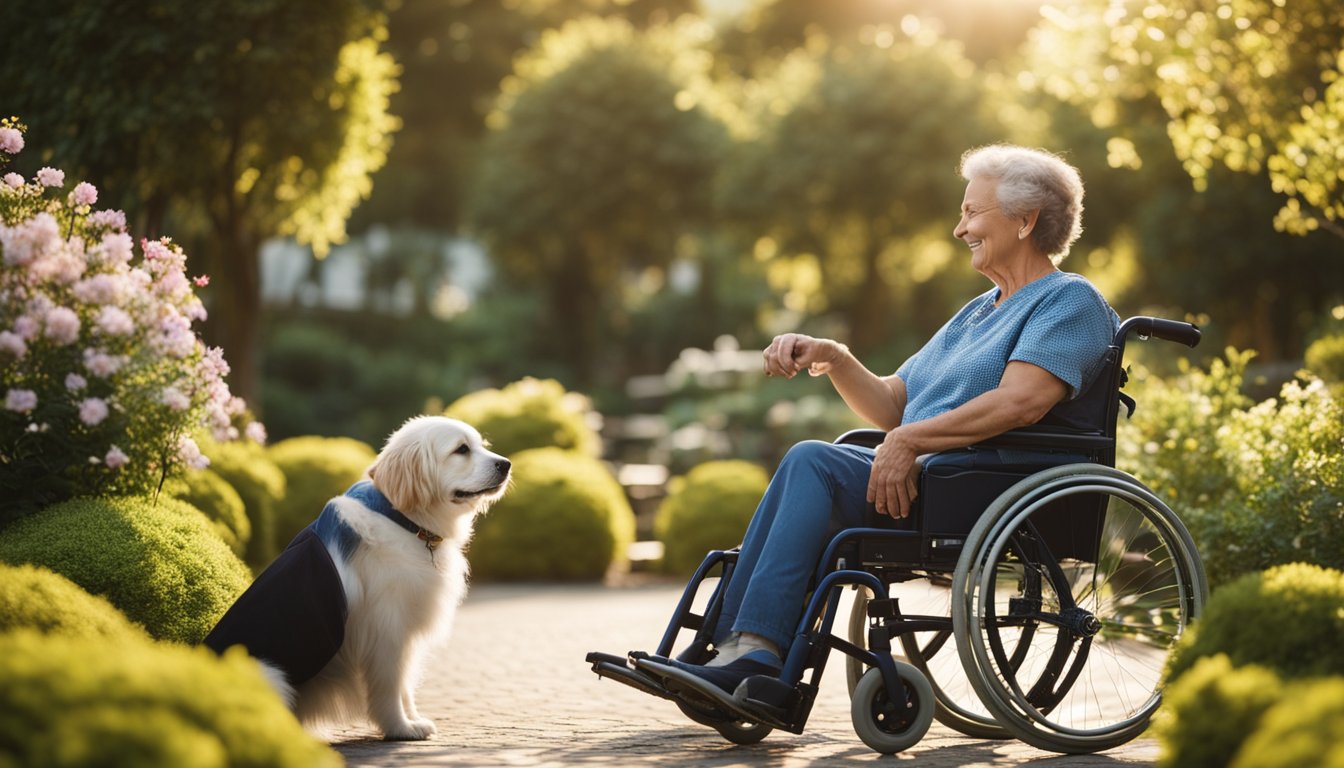Late updated: 07 May 2025 15:05
Written by: Ella Thompson
Exploring The Benefits Of Animal-Assisted Therapy In Recovery: Enhancing Mental Health and Well-being
Animal-assisted therapy (AAT) is gaining traction as a valuable component in the recovery process from various health issues, both physical and mental. Integrating animals into therapeutic practices not only helps in reducing stress and anxiety but also fosters a sense of calm and emotional openness, which is crucial for recovery. The power of animal-assisted therapy lies in its ability to enhance well-being by providing emotional, psychological, and physical benefits to those on their recovery journey.

Emotional bonds formed with therapy animals can lead to improved coping mechanisms, increased motivation, and even a significant reduction in symptoms related to mental health conditions. The inherent nature of animals to provide unconditional acceptance and companionship aids in creating a supportive environment conducive to healing. By offering unique benefits that complement traditional therapies, AAT holds transformative potential in fostering recovery.
Animal-assisted therapy works as a complementary approach, designed to enrich traditional therapeutic methods by enhancing overall patient engagement and well-being. The connection between humans and animals in a therapeutic setting often results in improved motivation, social functioning, and quality of life. These benefits highlight the growing importance of AAT in the comprehensive recovery process.
Key Takeaways
- Animal-assisted therapy offers emotional and physical benefits.
- AAT supports healing by enhancing traditional therapies.
- Emotional bonds with animals improve motivation and well-being.
Understanding Animal-Assisted Therapy in the Recovery Process
In recovery settings, animal-assisted therapy (AAT) harnesses the healing potential of therapy animals to address various emotional and psychological needs. AAT can significantly enhance engagement, connection, and progress in rehabilitation and addiction treatment settings.
What Is Animal-Assisted Therapy?
Animal-assisted therapy is an integrative approach that incorporates animals into therapeutic sessions to foster healing and recovery. It is a structured interaction where certified professionals employ therapy animals such as dogs, horses, or even small animals to promote emotional well-being. The comfort and companionship provided by these animals play a crucial role in engaging patients on an emotional level, ultimately aiding in reducing stress and encouraging social interactions.
An example of AAT in practice involves therapy dogs visiting drug rehab centres, where they can help patients alleviate feelings of isolation and anxiety. This method is widely recognised for its ability to create an atmosphere of trust and comfort, which often leads to enhanced therapeutic outcomes.
Key Principles of AAT in Treatment Settings
The principles that guide AAT in treatment settings are focused on enhancing the therapeutic bond and emotional connection between patients and therapy animals. Certified practitioners design these interactions to meet specific therapeutic goals, with animal companions serving as active participants in the recovery process.
This therapy requires strict adherence to guidelines to ensure the welfare of both animals and patients. Practitioners must be aware of each animal's behaviour and temperament to create a safe environment. Training and certification of therapy animals are vital to guarantee ethical standards are met in various recovery contexts like addiction treatment and mental health rehabilitation.
Types of Therapy Animals and Their Roles
Various animals are utilised in AAT, each serving unique roles based on their natural abilities and characteristics. Therapy dogs are widely used due to their affectionate nature and ability to follow commands. They are effective in calming patients and providing support during stressful situations.
Horses, used in equine therapy, can offer profound insights into a patient’s habitual patterns, promoting self-awareness and empathy. Some programmes also incorporate smaller pets, such as rabbits or guinea pigs, which can be particularly comforting for patients dealing with anxiety. The distinct roles of these animal companions contribute to a dynamic and tailored therapeutic experience in different rehabilitation scenarios.
Key Health and Emotional Benefits of Animal-Assisted Therapy During Recovery

Animal-assisted therapy (AAT) offers significant advantages in recovery by improving mental well-being, reducing emotional distress, and enhancing quality of life. The interaction with therapy animals can lead to profound psychological, social, and physical improvements.
Psychological and Emotional Effects
Interacting with animals can be notably soothing, serving as a catalyst for emotional healing in recovery. The bond formed between humans and therapy animals can release oxytocin, fostering feelings of calm and trust. This connection often leads to enhanced emotional well-being and coping mechanisms. For those dealing with trauma or PTSD, an emotional bond with therapy animals can alleviate distress and encourage a sense of safety and acceptance. The presence of animals brings comfort and companionship, supporting our emotional recovery journey.
Reduction of Depression, Anxiety, and Stress Levels
Animal-assisted therapy effectively lowers symptoms of depression, anxiety, and stress, crucial for recovery. Animals provide non-judgmental interaction, which can help patients feel more comfortable expressing emotions. The reduction of cortisol levels, a stress hormone, occurs naturally in the presence of animals, aiding in stress management. Such interaction also offers emotional support, promoting relaxation and improved mental health. Regular sessions with therapy animals can lead to significant improvements in mood and stress levels, creating a more favourable recovery environment.
Enhancing Social Interaction and Support
The presence of therapy animals facilitates social interaction and builds a supportive community. Engaging with therapy animals can enhance our social skills, making it easier to interact with others in group settings. This promotes a sense of belonging and reinforces social support networks, critical for many going through recovery. Therapy sessions involving animals often encourage communication and collaboration, fostering teamwork and a shared sense of purpose. Ultimately, the social benefits extend beyond therapy sessions, contributing to a more robust support system.
Physical and Occupational Well-Being
Animal-assisted therapy contributes to physical and occupational recovery by promoting an active lifestyle and offering structured routine. Activities such as walking or grooming therapy animals can improve physical health and mobility. Additionally, these activities integrate well with occupational therapy, aiding in the recovery of motor skills and coordination. The routine established through regular animal interactions provides stability and encourages discipline, which are essential for a successful recovery process. The overall physical well-being experienced during AAT sessions supports comprehensive healing and improved quality of life.
Frequently Asked Questions

Animal-assisted therapy (AAT) has shown promise in supporting individuals through various recovery processes, offering benefits such as reduced stress and improved mental health. Different factors contribute to its success, including the type of animals used and their impact on therapy sessions.
How does animal-assisted therapy support mental health during rehabilitation?
Animal-assisted therapy can bolster mental health by providing companionship, reducing loneliness, and fostering a safe environment for emotional expression. The presence of animals in therapy sessions often leads to increased patient engagement and enhanced motivation, which are crucial for successful rehabilitation.
What types of animals are most effective in animal-assisted therapy for recovery processes?
Dogs and horses are among the most commonly used animals in therapy due to their friendly nature and ability to form strong bonds with humans. Cats and small animals like rabbits can also be effective, offering gentle companionship that many find comforting.
Can animal-assisted therapy contribute to improved outcomes in substance abuse treatment?
Yes, animal-assisted therapy can contribute to improved outcomes in substance abuse treatment. By providing emotional support and reducing stress, therapy animals help individuals focus on their recovery goals. Patients may experience enhanced emotional regulation, which is vital for overcoming addiction.
What are the psychological mechanisms behind the success of animal-assisted therapy in recovery?
The success of animal-assisted therapy can often be attributed to the non-judgemental support that animals offer. This presence helps individuals rebuild self-esteem and trust, critical components in recovery. Interacting with animals can also increase feelings of empathy and responsibility, fostering personal growth.
How does the presence of animals in therapy sessions influence patient stress levels?
Patients frequently report lowered stress levels when animals are present during therapy sessions. Animals can help reduce cortisol levels, a stress hormone, and encourage relaxation. This calming effect often leads to improved concentration and openness during therapeutic activities.
Are there any risks or contraindications associated with animal-assisted therapy in recovery?
While generally beneficial, animal-assisted therapy may not be suitable for everyone. Those with allergies or phobias related to certain animals should exercise caution. Additionally, not every therapy animal will be a match for every individual, and careful selection is required to align goals and needs.
